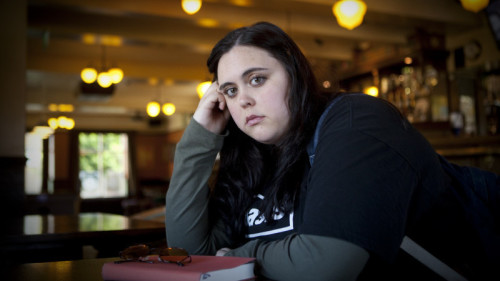This guest post by Ariana DiValentino appears as part of our theme week on Fatphobia and Fat Positivity.
Considering the number of things media aimed at teenage girls typically gets wrong, it’s refreshing to see a mainstream TV program getting it very, very right. My Mad Fat Diary is a British series about Rae Earl (played by Sharon Rooney), a 16-year old girl who is big in size and bigger in personality. Having just been released from a stay in a psychiatric hospital after a suicide attempt, the show follows Rae struggling with mental health and body image issues alongside the slew of other issues that come with being a teenage girl: friends, school, sex, and family.
From the outset, the show’s approach to Rae’s weight is spot-on. She’s not particularly confident in her appearance (what 16-year-old is?), but she is trying her damnedest. Unlike the pitfalls many “lovable fat person” stories fall into, happiness and overall self-acceptance for Rae aren’t attached to her losing weight—not even under the common guise of “loving oneself enough to take care of your body.” Weight loss is rarely the question for Rae. Working toward her own mental health, with the help of her straight-talking therapist Dr. Kester (Ian Hart), constantly is.
What makes My Mad Fat Diary stand out is how it brings all of these topics to life in a way that is undeniably entertaining. For one thing, it’s set in 1996, with throwback outfits and a soundtrack to match. When it wants to be, the show is dead funny, and not in a slapstick or grotesque way centered around Rae’s size. When she makes genuine jokes at her own expense—on her own terms, it’s funny; when neighborhood hooligans do, it’s righteously nauseating. Rae herself is a clever, sharp-witted and outspoken character who pokes fun at everything and anything, making her friends laugh as often as viewers. Surrounded by a quirky band of friends and an unconventional home life (her flighty mother is harboring her younger, non-English-speaking, undocumented immigrant boyfriend Karim from Tunisia in the house), Rae may describe herself as “mad,” but she is often the sanest character of the cast.
Some of the show’s best jokes (as well as troves of heart-wrenching moments) stem from Rae’s fully budded sexuality. Here still, there’s much less temptation to laugh at Rae than with her. While Melissa McCarthy’s overt sexuality in Bridesmaids, for example, derives its humour at least as much from the idea of a horny but sexually undesirable woman as from McCarthy’s truly hilarious farcicality, Rae’s sexuality doesn’t position her size as the butt of its joke. Rather, her private thoughts read like a Cosmo column that’s more colorful than internet literotica and yet more relatable than either of the two. Anyone who’s been a sexually frustrated adolescent can appreciate phrases like “sculpted piece of testosterone wonder” and her general outlook on butts. If only we had all had Rae’s wicked sense of humour at 16, not to mention her complete comfort with her own desires.
Rae’s maturity is about on par for her age, and as such, we cringe as she blunders through conflicts with boys, friends, and worst of all, her mother, with youthful brashness. Her adolescent perspective is written to a T, best exemplified in the sixth episode of Series 2, “Not I,” in which Rae is forced to confront the events of the past several months through the eyes of her pretty, popular, but equally insecure best friend, Chloe. Rae may be naïve at times, but the show itself is far from myopic. Even older viewers will be along for the ride as Rae deals with anxieties—such as her aversion to eating in front of people—that are perfectly expressed and at times, truly heartbreaking in their honesty.
And therein lies what makes the show such a wonderful example of fat positivity and feminism—Rae is, per her own description, mad and fat, but it takes less than a single episode to make it abundantly clear that she is so much more than that. Rae’s character and her problems are just so real. It’s rare enough for teenage girls to see positive representations of themselves onscreen, and even less so for those outside the typical beauty norms. Rae Earl is an extremely well-developed, well-written character—one we could all afford to take a cue from now and then when it comes to speaking up for others and advocating for our own well-being. My Mad Fat Diary and shows like it deserve to flood the airwaves from here to Lincolnshire.
Ariana DiValentino is a lover and budding creator of all things film and feminism, based in New York. Catch her in action on Twitter @ArianaLee721.




Love this show